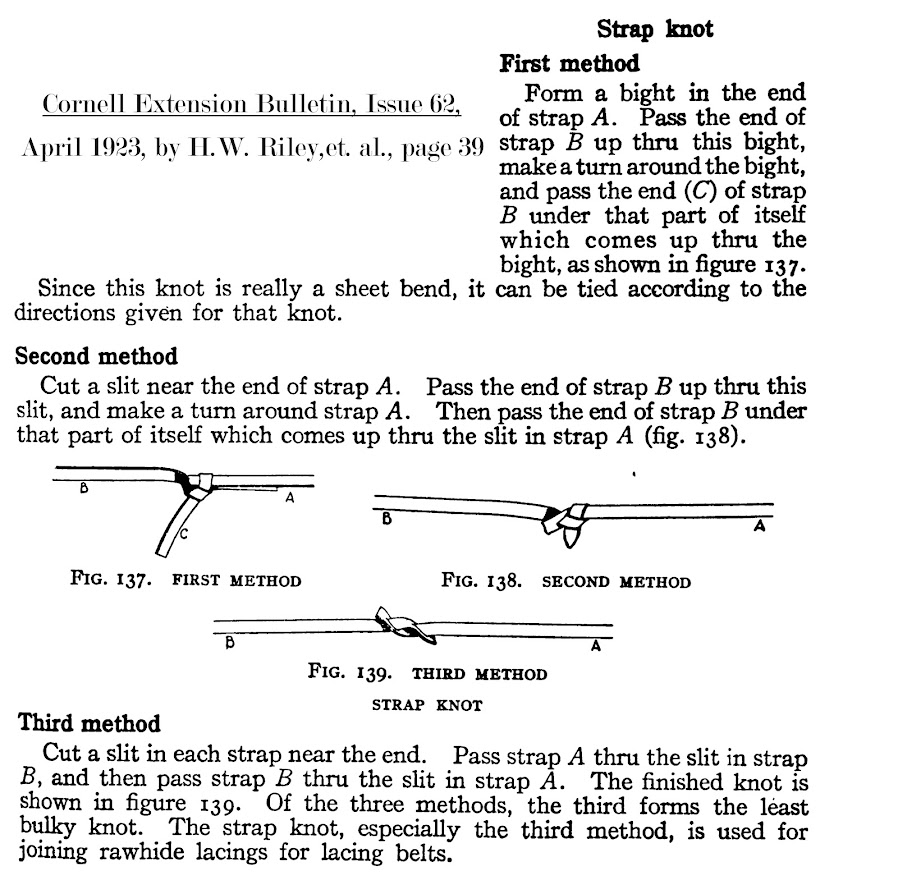They’re
not really knots, but the “Eskimo Loop” and the “Strap Knot” are
important “knots” to know how to make.
They were used to join two pieces of leather or rawhide thongs or to make
a loop in the end of a piece of rawhide or leather strap.
Bandanaman,
you say, “no one uses rawhide thongs or leather straps anymore, welcome to
the Plasticene Age, baby” ! But as Miracle
Max in Princess Bride, said “Whoo-hoo-hoo, look who knows so much...”
You’re
right, welcome to the Plasticene Age, baby!
Synthetic, nylon, plastic straps, how are you going to fix them when
they break? That’s right, just like they
did back in the leather and rawhide strap days.
The only difference is that you must melt any frayed or cut ends, to
prevent them from unraveling even more.
Getting
started...
You
need a very sharp knife, or a razorblade, to cut and slit the straps. If you have a lighter, the blowtorch type
works the best, so you can melt the edges to prevent them from unraveling. However, be careful that you don’t singe your
fingers, and remember melted plastic leaves nasty burns.
When
cutting the slits in the straps, it is best to start at the end and cut AWAY
from it—this prevents accidentally cutting too far and going through the end of
the strap.
The Strap Knot
and Eskimo Loop...
A “strap knot” is used to splice two straps together and is an
excellent way to field-repair damaged tie-down straps or backpack straps. There are three ways to make a strap knot,
the first method is to use a sheet bend knot to tie the two ends together. However, this method uses up strapping that
you might not have. That is where the
second and the third method come in.
Method three is the simplest and uses the least amount of strapping and
makes the least bulky knot. Cut a slit
in the center of each strap, one and one-half times as long as the straps are
wide. Pass strap A through the slit in
strap B, and then pass strap B, through the slit in strap A
The “eskimo loop” can be used to reattach backpack buckles when
you don’t have a sewing kit, by making a loop in a strap. Make a slit near the end of the strap that is
one and one-half times as long as the strap is wide, then make a second slit
that is only as long as the strap is wide, above the first slit at the length
needed for the loop. Pass the end of the
strap, through the second slit and then pass the other end of the strap through
your first slit.
Hopefully, your gear never breaks on you in the wilderness, but if it
does remember the eskimo loop and strap knot, they will make your field-repairs
much easier!
I
hope that you continue to enjoy The Woodsman’s Journal Online and look for me
on YouTube at BandanaMan Productions for other related videos, HERE. Don’t forget to follow me on both The
Woodsman’s Journal Online, HERE,
and subscribe to BandanaMan Productions on YouTube. If you have questions, as always, feel free
to leave a comment on either site. I
announce new articles on Facebook at Eric Reynolds, on Instagram at
bandanamanaproductions, and on VK at Eric Reynolds, so watch for me.
That
is all for now, and as always, until next time, Happy Trails!
Sources
Ashley, Clifford W.; The
Ashley Book of Knots, [Geoffrey Budworth, Kent, England, 1993], https://www.liendoanaulac.org/space/references/training/Ashley_Book_Knots.pdf, accessed January 25, 2022
Boas,
Franz; The Eskimo of
Baffin and Hudson Bay, Volume 15,
[Trustees of The American Museum of Natural History, New York, N.Y., 1901],
page 34-36, https://books.google.com/books?id=O9AvAQAAMAAJ&pg=PA36&dq=eskimo+loop+knot&hl=en&newbks=1&newbks_redir=0&sa=X&ved=2ahUKEwjqiKfggIKHAxXzFVkFHXgiCx8Q6AF6BAgIEAI#v=onepage&q=eskimo%20loop%20knot&f=false, accessed July 5, 2024
Hillcourt, William; “Let’s
Shuffle Along”, Boys' Life, January 1943, page 7 – 8, [Boy Scouts of
America, New York, NY, 1943], https://books.google.com/books?id=F5QkFwOcUioC&pg=PA9&dq=splicing+thongs&hl=en&sa=X&ved=2ahUKEwiVn9_sl4KHAxXlEmIAHaSXBzMQ6AF6BAgEEAI#v=onepage&q=splicing%20thongs&f=false, accessed July 5, 2024
Kephart, Horace; Camping
and Woodcraft: A Handbook for Vacation Campers, Volume 2, [The Macmillan
Company, New York, NY, 1923], pages 316, https://books.google.com/books?id=D80g7lyu_l4C&pg=PA316&dq=splicing+thongs&hl=en&newbks=1&newbks_redir=0&sa=X&ved=2ahUKEwiVn9_sl4KHAxXlEmIAHaSXBzMQ6AF6BAgLEAI#v=onepage&q=splicing%20thongs&f=false,
Accessed July 5, 2024
Powell, J.W.; Annual
Reports, Volume 9, 1887-88, [Government Printing Office, Washington, D.C.,
1892], page 301-302, https://books.google.com/books?id=a9gRAAAAYAAJ&pg=PA312&dq=eskimo+knot&hl=en&newbks=1&newbks_redir=0&sa=X&ved=2ahUKEwi-wqC9iYKHAxWDFlkFHZyuAec4MhDoAXoECAcQAg#v=onepage&q=eskimo%20knot&f=false,
accessed July 5, 2024
Riley, H.W., Behrends,
F.G., Robb, B.B.; Cornell 4-H Club Bulletin, Bulletin 13, June 1925,
[Cornell University, Ithaca, NY, 1925], page 7, https://books.google.com/books?id=ATc5AQAAMAAJ&pg=RA7-PA8&dq=%22strap+knot%22&hl=en&newbks=1&newbks_redir=0&sa=X&ved=2ahUKEwjywLLa55CHAxXfMlkFHUAEBhMQ6AF6BAgEEAI#v=onepage&q=%22strap%20knot%22&f=false,
accessed July 5, 2024
Riley, H.W., Behrends,
F.G., Robb, B.B.; Cornell Extension Bulletin, Issue 62, [Cornell University,
Ithaca, N.Y., April 1923], page 39
https://books.google.com/books?id=v_cjAQAAMAAJ&pg=RA11-PA39&dq=%22strap+knot%22&hl=en&newbks=1&newbks_redir=0&sa=X&ved=2ahUKEwjywLLa55CHAxXfMlkFHUAEBhMQ6AF6BAgJEAI#v=onepage&q=%22strap%20knot%22&f=false,
accessed July 5, 2024
Roehl, Louis Michael; Rope
Work, [The Bruce Publishing Co., Milwaukee, W.I., 1921], page 26, https://books.google.com/books?id=PjJRuN6V5nIC&pg=PA26&dq=%22strap+knot%22&hl=en&newbks=1&newbks_redir=0&sa=X&ved=2ahUKEwjywLLa55CHAxXfMlkFHUAEBhMQ6AF6BAgIEAI#v=onepage&q=%22strap%20knot%22&f=false,
accessed July 5, 2024
Wessel, Bill; “Leather
Work: Second Session”, Scouting, Volumes 15, No, 4, [Boy Scouts of
America, New York, NY, 1927], page 7, https://books.google.com/books?id=Q_e-HRHkl4oC&pg=RA26-PA7&dq=splicing+thongs&hl=en&newbks=1&newbks_redir=0&sa=X&ved=2ahUKEwiVn9_sl4KHAxXlEmIAHaSXBzMQ6AF6BAgFEAI#v=onepage&q=splicing%20thongs&f=false,
accessed July 5, 2024





No comments:
Post a Comment